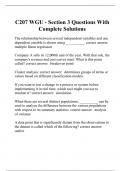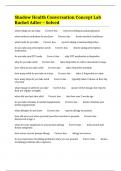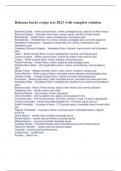Lectures 8-14 (2024)
Yulia Göbel
Leiden University, Campus the Hague
, Table of Contents
LECTURE 8: FUNDAMENTALS SAFETY SCIENCE II BY VAN GELDER.......................................................1
CONCEPTS..........................................................................................................................................1
FORMULA..........................................................................................................................................1
SUMMARY.........................................................................................................................................2
RECAP...............................................................................................................................................3
LECTURE 9: DESIGNING NUCLEAR SAFETY BY TAEBI...........................................................................4
CONCEPTS..........................................................................................................................................4
SUMMARY: DESIGN SAFETY THROUGH ENGINEERING.....................................................................................5
SUMMARY: DESIGN GOVERNANCE..........................................................................................................10
RECAP.............................................................................................................................................13
LECTURE 10: MEASURES AND RECOVERY AFTER THE ACCIDENT BY NANBA.....................................14
SUMMARY........................................................................................................................................14
LECTURE 11: HEALTH & ENVIRONMENTAL EFFECTS BY THOMAS & SMITH.......................................15
CONCEPTS........................................................................................................................................15
SUMMARY........................................................................................................................................16
HEALTH EFFECTS........................................................................................................................................16
ENVIRONMENTAL EFFECTS...........................................................................................................................20
RECAP.............................................................................................................................................23
LESSON 12: JAPANESE POP CULTURE & ART BY PERLSTEIN & KAWAKUBO.......................................24
CONCEPTS........................................................................................................................................24
SUMMARY I BY PERLSTEIN...................................................................................................................24
RECAP POP CULTURE...........................................................................................................................25
SUMMARY II BY KAWAKUBO.................................................................................................................25
LECTURE 13: NUCLEAR COMMUNICATION BY TSUBOKURA & TAKAHASHI.......................................26
SUMMARY I BY TSUBOKURA.................................................................................................................26
POST ACCIDENT FOOD SAFETY SCIENCE.........................................................................................................26
SUMMARY II BY TAKAHASI...................................................................................................................28
CONCEPTS................................................................................................................................................28
RECAP.............................................................................................................................................32
LECTURE 14: CRISIS DECISION-MAKING BY BROEKEMA...................................................................32
CONCEPTS........................................................................................................................................32
SUMMARY........................................................................................................................................32
, Fukushima (summary II)
Lecture 8: fundamentals Safety science II by van Gelder
Concepts
Domino type of failure= dependency of the failures.
Expected value= take the decision which maximizes the expected
payoff.
Hurwicz Criterion= how much is your own coefficient of optimism
(choose the
maximum outcome)?
Laplace Criterion= take the decision which maximizes the average
payoff.
Calculate for every decision the average payoff and
choose
the highest number.
Maximax Criteria= take the decision which maximizes the maximum
payoff
(optimistic)
Maximin Criteria= take the decision which maximizes the minimum
payoff
(pessimistic).
Minimax Regret Criterion= minimize your maximum regret. How much
is the
regret if another scenario would’ve occurred.
Profit= the difference between the revenue and the costs.
Risk analysis= only analysing the risk as a function of something.
Risk management= cost-benefit analysis decision-making > risk-
reduction.
Sensitivity analysis (intuition)= what do you expect with the optimum
number
(Base on cost-benefit analysis) of components in a system if something
happens with the parameters (qualitative).
Willingness-to-pay= reduction in the expected number of fatalities
divided
(WTP) by the investment
Formula
Hurwicz Criterion Calculation= a (Max. payoff) + (1-a)(Min. payoff)
(Pess. = 0 1 = Optim.)
Probability for series system= P(A U B)= P(A) + P(B) – (P(A) *P(B))
When combination of parallel & series system = multiply the parallel to
one outcome!
Profit calculations= revenue – costs. (Could use payoff matrix or decision
tree).
The outcome variable calculation is a function of the decision taken and
the scenario that takes place.
Absolute difference between the probability of TE and the probability of TE
> component Y does not fail.
Relative difference > dividing it by the
probability of the Top Event.
Page 1 of 38











